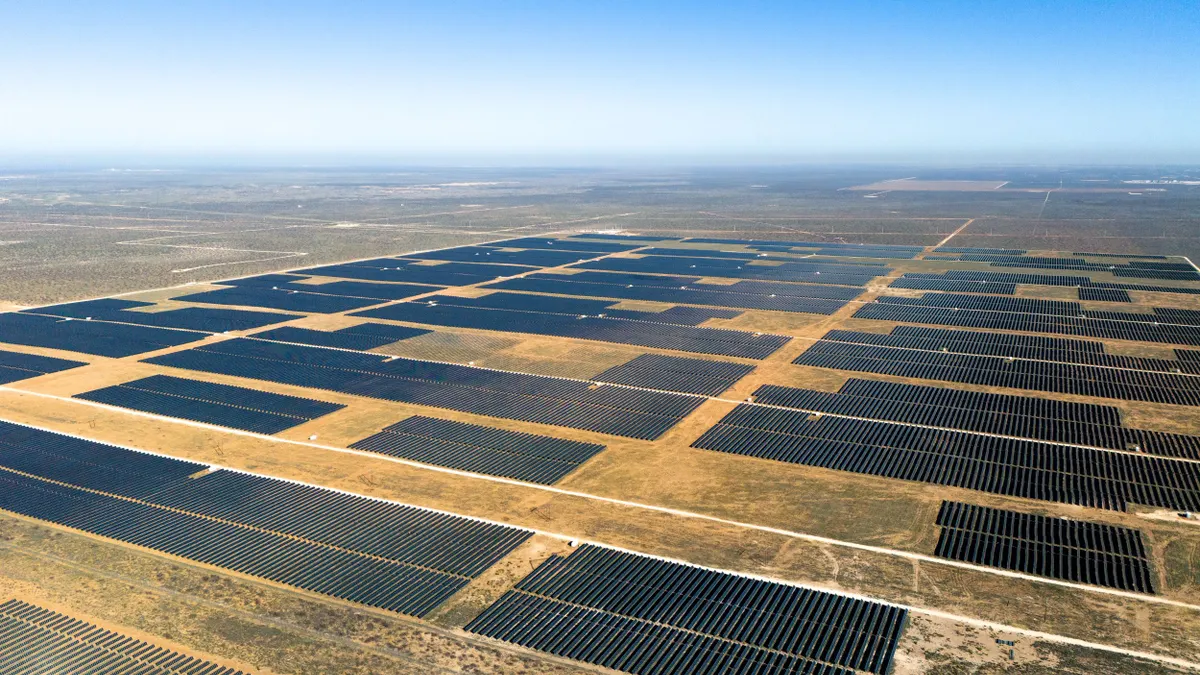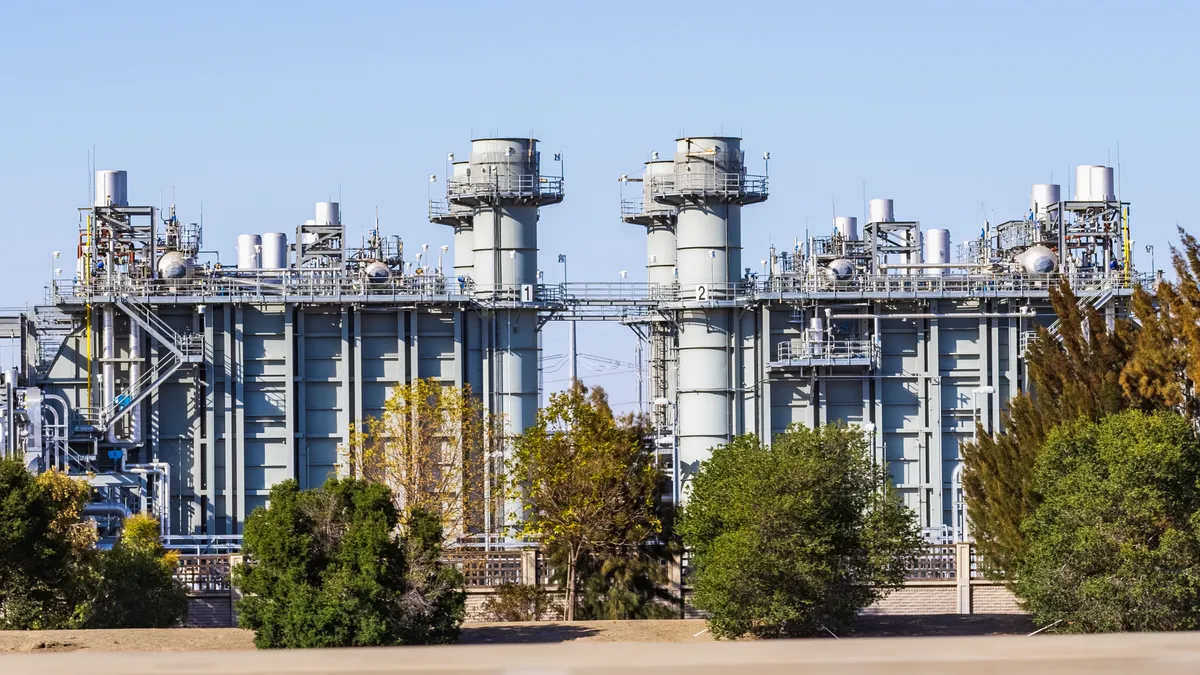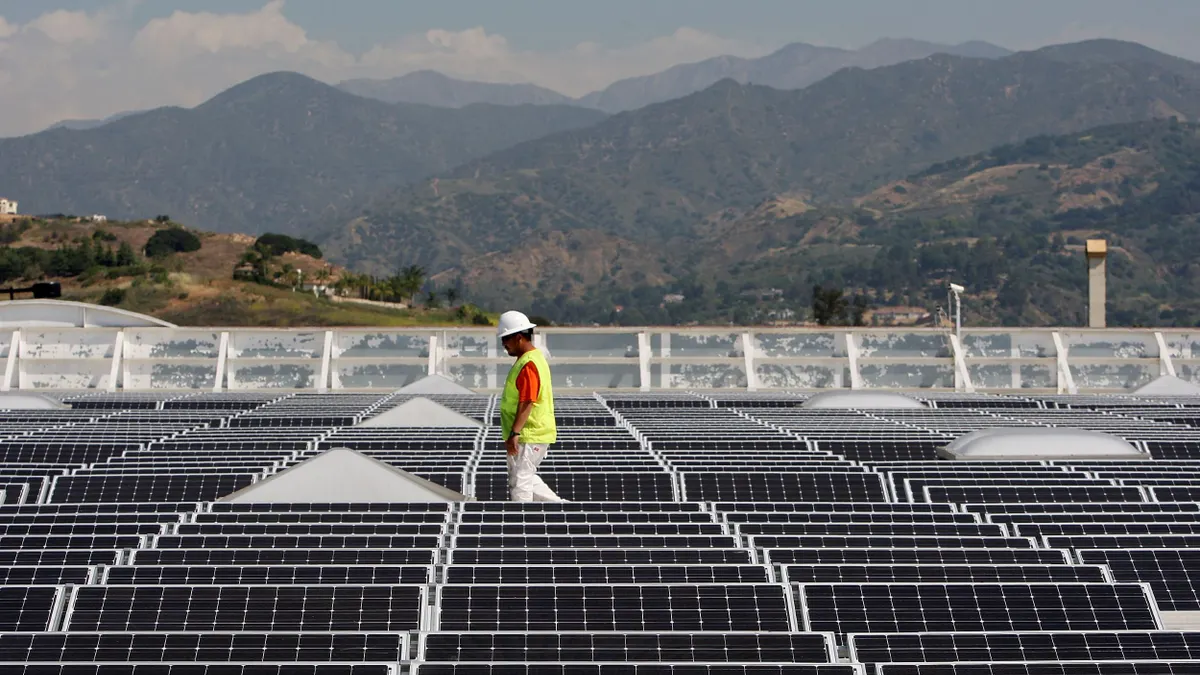Editor’s note: This story is part of the Utility Dive Outlook on 2021, a series on the trends that will shape the industry in 2021. For a look at the business trends affecting other industries, see the Dive Outlook on 2021.
At this time last year, few people — if anyone — could have predicted what 2020 would bring.
That tumultuous year has not yet led to a calmer one, but if January 2020 taught us anything, it's that the first days of a new year may not always be a sign of what's to come. With that being said, Utility Dive spoke to over half a dozen power sector experts who tentatively predict big changes on the horizon in 2021.
A new administration under a new party is one of many signs that 2021 will look different for policymakers, regulators, utilities and other stakeholders, but the continuation of some older trends is expected as well: Utilities will continue to invest aggressively in renewable energy resources, and the power sector will continue to evolve toward a less centralized model.
Here are 10 stories to watch in 2021:
Biden Administration, paired with Democrat-led Congress, will lead to major federal policy shift
President-elect Joe Biden during his campaign outlined a $2 trillion plan to bring the U.S. electric grid to 100% zero-carbon resources by 2035. Though stakeholders are skeptical such a plan could pass Congress, they expect a Democrat-led Senate will yield big investments in green infrastructure, and broadly lead to a greater focus on climate and clean energy at the federal level.
Analysts expect expanded and upgraded transmission along with increased electric vehicle deployment to be targets of Congress and the administration, with some experts optimistic that something like a federal clean energy standard could be set.
Accelerated investments in EVs, transmission and other green infrastructure are expected to come through a new stimulus package that would ideally target state and local aid, freeing up state budgets so that they can pursue large, comprehensive clean energy packages of their own, according to J.R. Tolbert, managing director at Advanced Energy Economy.
At the same time, the new administration creates a more optimistic outlook for renewables, as evidenced by the rise of various clean energy stocks in the wake of Democrats' two Senate victories in Georgia, while fossil fuels' future — and the practicality of investment in those resources — remains uncertain, according to analysts.
FERC will be seen as ‘linchpin' of clean energy progress
A more aggressive federal approach to clean energy will require a more aggressive Federal Energy Regulatory Commission, observers say.
"The focus on the agency, as a linchpin of clean energy policies, has really been pretty remarkable," said Jeff Dennis, managing director and general counsel at Advanced Energy Economy (AEE). "There's gonna be a lot of expectations, and they're going to have to prioritize, given bandwidth."
Part of the commission's challenge will be in how it should address the commission's controversial expansion of the minimum offer price rule in the PJM Interconnection and its elimination of buyer-side mitigation rules in the New York Independent System Operator (NYISO) market, Dennis and other observers say. Biden is expected to name a new commission chair quickly, but FERC will still be a majority-Republican body until the end of Commissioner Neil Chatterjee's term June 30, which may make pursuing action to reverse or otherwise diminish the MOPR and BSM orders more difficult to do immediately, according to experts.
Both Democrat-appointed FERC commissioners have made it clear that climate change can and should play a role in FERC decision-making, which could mean greater consideration of greenhouse gas emissions and environmental justice when approving major gas infrastructure projects.
Transmission planning reform is one area where there is likely to be stronger bipartisan consensus at FERC, observers say, and unlocking transmission is considered crucial to broader U.S. renewable energy deployment, making it something Congress and others parts of the Biden administration could target as well.
Gas may face reckoning
Natural gas prices have fallen dramatically in recent years and smaller, more flexible peaker plants have regularly been referred to as a "bridge fuel," or a lower-emissions alternative to coal that still operates in a central, dispatchable manner. But increased urgency and data on climate change, coupled with a new administration, could make gas a less appealing investment, according to stakeholders.
Though Biden promised to avoid a ban on fracking gas, a new FERC may make permitting trickier. Once Democrats have the majority, the commission may also be more willing to take into consideration climate and community impacts when considering building out gas infrastructure.
"One thing we're waiting for with bated breath is who's gonna dare to try and be the first to talk about how they decarbonize their gas business."

Leia Guccione
Managing Director, Rocky Mountain Institute Electricity Program
Commissioner Richard Glick, the longest-serving Democrat appointee on the commission, has long indicated he thinks the commission should consider greenhouse gas emissions when looking at pipeline and other gas infrastructure proposals. The commission's other Democrat, Allison Clements, has similarly indicated she believes FERC should consider climate change and other factors in its decision-making.
On the utility side, pressure to stop building out gas infrastructure is only anticipated to grow from advocates, said Leia Guccione, managing director for the Rocky Mountain Institute's Electricity Program. Though utilities are cutting carbon quickly from their electric portfolios, climate science requires even more aggressive actions, meaning utility gas subsidiaries will be targeted next.
"One thing we're waiting for with bated breath is who's gonna dare to try and be the first to talk about how they decarbonize their gas business," Guccione said.
All eyes will be on Southeast and West energy market discussions
Southeast utilities' proposal to form a centralized energy exchange market — the Southeast Energy Exchange Market (SEEM) — could play an interesting role in the debate over whether to open more regions to wholesale market competition.
Many clean energy proponents want to see full competition in the Southeast, with research and consulting firms Energy Innovation and Vibrant Clean Energy finding such a market could save $384 billion by 2040. But advocates in the state worry the utilities' proposal could undermine legislative and regulatory efforts to open up North and South Carolina to such competition.
"What role the SEEM plays in that, if any, that's something to look at," said Mike O'Boyle, director of Electricity Policy for Energy Innovation. North Carolina regulators blocked utilities from filing the proposal with FERC until the state decides whether it should take a greater oversight role in the process.
If the SEEM proposal does get to FERC, the big question will be what the commission does with it, according to Dennis.
"Will they use it as an opportunity to engage with the states in the region, and with large customers in the region, and renewable developers in the region around what the future of wholesale markets looks like in the region?" he said, in addition to digging into whether SEEM itself is a structure they would approve.
Developments in the largely unstructured Western markets will continue as well, say observers, and stakeholders will certainly watch as Western utilities mull the comparative benefits of newer imbalance market creations from the Southwest Power Pool or the California ISO's existing energy imbalance structure. A key issue swirling around Western market organization is ensuring California and other western states better coordinate to ensure resource needs are met, to avoid a repeat of last year's rolling blackouts in California.
Stakeholders will closely watch California's resource adequacy proceeding
How California prepares its grid for this summer is something regulators, lawmakers, regional grid operators, utilities and others are likely to keep a close eye on, according to analysts.
A major heat wave and weak resource adequacy margins triggered rolling blackouts in the state that lasted several days last August. Now, CAISO and the California Public Utilities Commission are focused on preparing for next summer, and stakeholders say how they address the issue of resource adequacy will be essential in creating a path forward for other states and grid operators as they shift toward more variable generation resources.
"It is a CAISO problem, not a clean energy problem."

J.R. Tolbert
Managing Director, AEE
"It puts California in the spotlight," said James Pryde, partner in the Energy and National Resources Group at the Bryan Cave Leighton Paisner law firm.
FERC Chairman James Danly's attempt to initiate a federal investigation into the outages was rejected by the commission majority, which argued in part that getting federal regulators involved would hinder the state's process. But though some federal lawmakers have implicated solar as the culprit of the blackouts, stakeholders say it's more complicated than purely an issue of variable resources.
"It is a CAISO problem, not a clean energy problem," said Tolbert. Part of the solution will require CAISO and the CPUC to fundamentally rethink resource adequacy and how [they] will account for hybrid resources and demand response as part of that calculation, said O'Boyle.
Utilities will make more hydrogen announcements, resource plans will take a closer look at hybrid resources and portfolios
Clean energy advocates hope 2021 will see utilities be more creative in their long-term resource planning, looking to renewables-plus-storage hybrids and clean energy portfolios to replace plans to build out more natural gas infrastructure.
New Mexico regulators in July unanimously selected a 100% renewables and storage portfolio for the Public Service Company of New Mexico to replace a portion of the soon to be shuttered San Juan coal plant. Regulators chose the renewables plan over one that would have added gas resources to replace the capacity, finding the former was cheaper and more in line with the state's requirement to reach 100% carbon-free energy by 2045.
"Investors and industry are beginning to recognize that hydrogen may be able to provide the on-demand generation that can help ensure grid reliability."

Bernard McNamee
Partner, McGuireWoods law firm
To generate more of these kinds of commitments, there needs to be a shift in how long-term resource planning is done, said Kathleen Spees, principal at consulting firm The Brattle Group.
"A lot of the folks who do the integrated plans and the resource planning are going to have to ... rethink how they do everything," she said. "A lot of the traditional approaches are just really designed around figuring out how much of a traditional resource you need, they're really not figuring out how you can get the most out of the new tech."
Hydrogen is another zero emission resource that received a lot of attention at the end of 2020. As a result, analysts expect more utilities to include it in long-term resource plans, though cost barriers will likely prevent actual deployment in the next year.
"Investors and industry are beginning to recognize that hydrogen may be able to provide the on-demand generation that can help ensure grid reliability," Bernard McNamee, former FERC commissioner and partner at McGuireWoods law firm, said in an email. "[B]ut right now, the challenge is making it cost-effective."
Decline of U.S. coal economics expected to propel financing exit. Stakeholders will need to address transition
Coal economics have been in decline for years now and are not expected to bounce back.
Blackrock, the largest asset manager in the world, at the start of 2020 said it would exit investing in thermal coal production altogether, citing it as a "high sustainability-related risk." Other investment companies are similarly urging utilities to back away from coal-fired investments, a call that's only expected to grow louder, said Guccione.
"You're gonna start to see all of the flavors of the financial sector start to either take action or express opinions around their risk tolerance for coal, their willingness to have coal in their portfolios, [or] what they're expecting utilities or other merchant companies who own coal to be doing with it," she said. Rapid definancing of the sector raises the urgency for regulators and lawmakers to address transitioning communities impacted by the change, determining how to best finance early retirements, and finding creative ways to clean up and repurpose old coal sites.
Securitization is one approach that's been consistently raised as an option for vertically-integrated, regulated utilities by allowing them to pay off stranded asset debt, and can free up additional funds for worker release and economic development. Stakeholders in Missouri, for example, are hoping securitization legislation gets enacted this year, in an effort to encourage Ameren to retire its coal plants quicker.
A lot of questions still remain for how to address coal shutdown transitions with public and member-owned utilities though, said Guccione, and solving that problem may require federal action.
"We see opportunities for the new administration, through various forms of federal action, to do something there," she said.
Electric vehicles will be more accessible, raising charging, load questions
Declining battery costs are expected to boost the selection and price of electric vehicle models available in the market dramatically, which experts say is key to amplifying EVs' overall market share.
"It's no longer the crazy man's or rich guy's hobby," said Morten Lund, partner at law firm Stoel Rives' Energy Development group.
Models available to U.S. customers are anticipated to more than triple in the next three years, according to the Electric Power Research Institute, jumping from roughly 40 to 127. Those new models include electric pickup trucks, filling a major vacancy in the EV market, according to AEE.
Corporate-level EV interest is soaring as well with major transport-heavy companies such as Amazon to buy more EVs. School bus electrification is also getting more attention, alongside broader trucking fleets.
A potential boon in the number of EVs on the road will raise critical questions about how to manage large additional loads of electricity, how to deploy charging stations quickly, and how to determine ownership of charging stations, experts say.
"Everybody's behind on charging infrastructure, and it has big implications for the market," said Matt Stanberry, managing director at AEE, "So there's a lot of interest in it."
Utilities, renewable energy firms will have to assess COVID-19 recovery
Though the power sector remained relatively stable during the COVID-19 pandemic and economic crisis, some renewables projects saw delays, solar saw a slight dip in installations, and utilities saw some declines and shifts in load.
For the renewables market, tax credit extensions that came in the latest economic stimulus package coupled with the Biden administration's pro-renewables bent could help buoy the sector against a potential slump later this year, said Lund.
"We managed through 2020, essentially on built up inertia and fumes. But that could start running out," he said, in part based on "the sheer uncertainty" facing the markets. "The nice float that we had last year can only continue so long. And we just don't have a good sense for how much longer we can sustain ourselves on inertia," he added. The renewables industry is expected to continue lobbying Congress for direct pay options to replace the tax credits and give the sector more certainty.
On the utility side of things, a major question is how debt from $40 billion in unpaid utility bills will be paid off.
"That's definitely going to be a big issue, from a general utility sector point of view," said O'Boyle.
Cyber remains a threat, and a bipartisan issue
Cyber attacks continue to present a growing threat to the power grid, and targets are more variable as the grid becomes more digital and decentralized. Federal regulators are taking a more vested interest in incentivizing utilities to harden their systems more aggressively, particularly as studies find power providers to be particularly at-risk of an attack.
An unprecedented cyber attack uncovered near the end of 2020 has only heightened scrutiny. Stakeholders hope cybersecurity, which continues to receive bipartisan support, will see more legislative and regulatory action in 2021.
"Cybersecurity is the one issue in Washington that hasn't been politicized — everyone knows the threats to the grid are real," said McNamee.






















